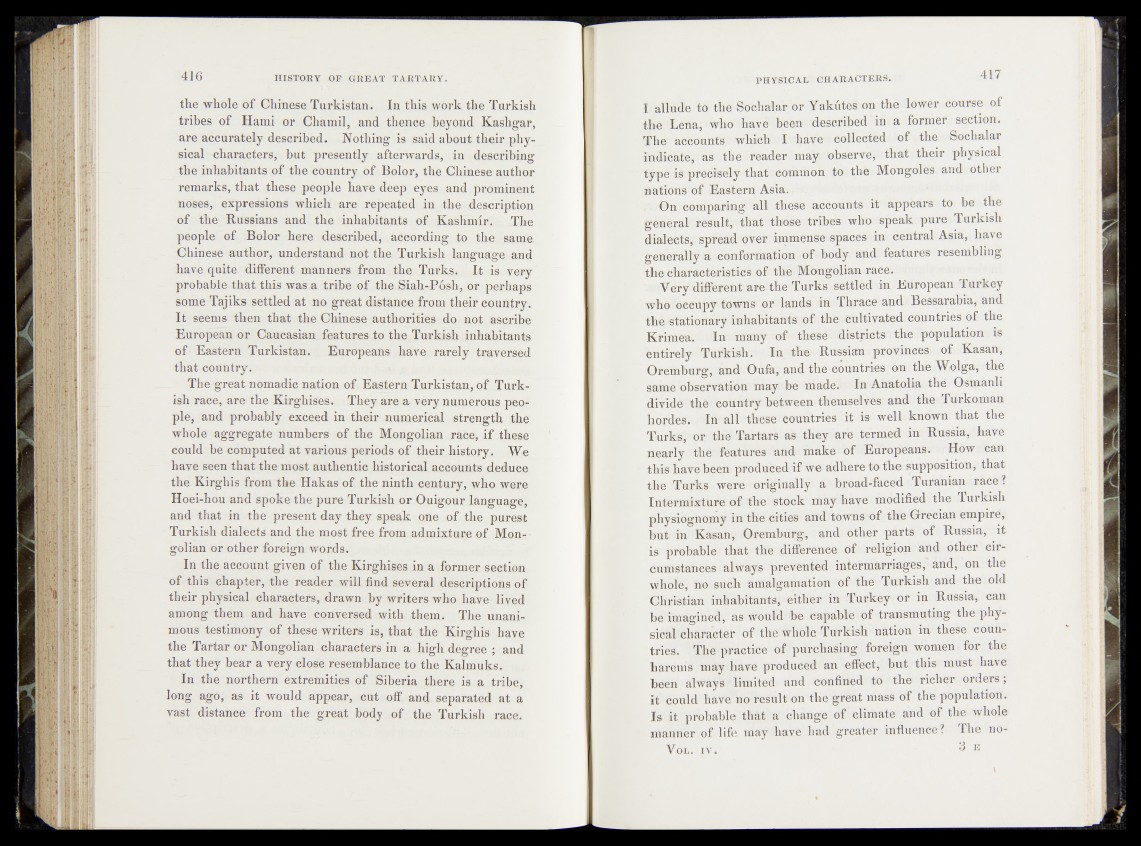
the whole of Chinese Turkistan. In this work the Turkish
tribes of Hami or Chamil, and thence beyond Kashgar,
are accurately described.: <■ Nothing is said about their physical
characters, but presently afterwards, in describing
the inhabitants of the country of Bolor, the Chinese author
remarks, that these people have deep eyes and prominent
noses, expressions which are repeated in the description
of the Russians and the inhabitants of Kashmir. The
people ©f Bolor here described, according #e the sawfe
Chinese author, understand not the Turkish l&nsruaffG and
have quite different manners from the Turks. It is very
probable that this was a tribe of the Siah-Pésh, or perhaps
some Tajiks settled at no great distance from their country.
It seems then that the Chinese authorities ado, sot; ascribe
European or Caucasian features to the.Turkish inhabitants
of Eastern Turkistan. Europeans hare rarely traversed
that country.
The great nomadic nation of Eastern Turkistan, of Turkish
race, are the Kirghises. They are a very ne.merous peer
pie, and probably exceed in their numerical strength the
whole aggregate numbers of the Mongolian race*.if these
could he computed at various periods of their history. We
have seen that the most authentic historical accounts deduce
the Kirghis from the Hakas of the ninth century, who were
Hoei-hou and spoke the pure Turkish or Ouigour language,
and that in the present day they speak one of the purest
Turkish dialects and the most free from admixture of .Mongolian
or other foreign words.
In the account given of the Kirghises in a former section
of this ehapter, the reader will, find several descriptions of
their physical characters, drawn by writers who have lived
among them and have conversed with them. The unanimous
testimony of these writers is, that the Kirghis have
the Tartar or Mongolian characters in a high degree ; and
that they bear a very close resemblance to the Kalmuks,
In the northern extremities of Siberia there is a tribe,
long ago, as it would appear, cut off and separated at a
vast distance from the great body of the Turkish race.
I a llu d ed the* Söêhalar or Yakótes on the. lower course of
the "Lena, who havetëfeëèn^described ' in - a former section.
The W^anfsb^which I ha^^®oHected of the Sochalar
indicate*/' as^rthe 1 reader may observefb that their physical
type ^prbel^ofy that common to the Mongoles and other
nations ’ of *Eaate¥n' Asia.; ^
On comparing all thesfe-accounts it appears to be the
general result, dkat'these trikes, who-.-speak pureo Turkish
dialects*-spread Jove® immen^s^aoBsiwftvcentral Asia, have
generally é conformationMifebotly. and features resembling
the characteristics of the Mongolianirace.1- >
. VerydMoisent are the Turkfebèttlèdrin European Turkey
who occupy towns' or lands Thrace, and Bessarabia, arid
the’ sMtionaryrinhabitants of the scnltivatecLcountries of the
KririW&di In-many of these-'- districts the population is
- entirely Turkish. In the> Russian provinces of Kasan,
Oremburg, and Oufa, and the countries on the Wolga, ’the
same observation- mayriteJtfadeii-' In Anatolia the Osméoli
divide f h èr^coun t ry> b et we ên^ them s el ves' and therTurkoman
"In hM tllpe^ountries a t is wellt known that the
Turks,-5®! the Tartars as they iare termed in Russia, have
nearly itfee5 feathr^and make of ’Ëüroheans. How can
this have been produced if we adhere to the supposition* that
the Turks were originally a broad-faced-^Turanian race?
Intermixture of the’5 stock may have modified the Turkish
physiognomy in the cities and towns of the Grecian empire,
bufr'iri Kasan, Oremburg, and other parts of Russia* it
is probable that the difference of religion and other circumstances
always prevented intermarriages, and, on the
whole, no such amalgamation of the Turkish and the old
Christian inhabitants* either in Turkey.*,or in Russian, can
he imagined, as would be capable of transmuting the physical
character of the whole Turkish nation in these countries.
The practice of purchasing foreign women for the
harems may have produced an effect, hut thismust have
been always limited and confined to the richer orders,
it could have no result on the great mass of the population.
Is it probable that a change of climate and of the whole
manner of life may have had greater influence ? The no-
VoL. IV. ' B I 3 E